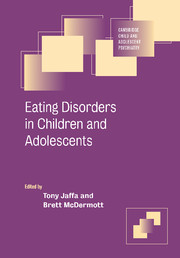Book contents
- Frontmatter
- Contents
- List of Contributors
- Part I Introduction
- Part II Scientific underpinnings
- Part III Abnormal states
- Part IV Evidence-based care
- 16 Assessment and treatment of acute medical complications during the refeeding process
- 17 Assessment and treatment of chronic medical complications
- 18 Individual psychotherapy
- 19 Evidence-based family psychotherapy interventions
- 20 Models of service delivery
- 21 Psychopharmacology and eating disorders
- Part V Public health perspectives
- Index
- References
18 - Individual psychotherapy
from Part IV - Evidence-based care
Published online by Cambridge University Press: 02 December 2009
- Frontmatter
- Contents
- List of Contributors
- Part I Introduction
- Part II Scientific underpinnings
- Part III Abnormal states
- Part IV Evidence-based care
- 16 Assessment and treatment of acute medical complications during the refeeding process
- 17 Assessment and treatment of chronic medical complications
- 18 Individual psychotherapy
- 19 Evidence-based family psychotherapy interventions
- 20 Models of service delivery
- 21 Psychopharmacology and eating disorders
- Part V Public health perspectives
- Index
- References
Summary
Introduction and overview
To therapists and clinicians treating children and adolescents with eating disorders, the title ‘individual psychotherapy’ may appear a misnomer. Children and the majority of adolescents do not present alone and it is important in management to also engage family members, and others such as school counsellors. Guidelines and position statements for the specific care of young people emphasize this (Kreipe, 1995; National Institute for Clinical Excellence (NICE), 2004). Individual psychotherapy in most instances, particularly with children, should occur following a thorough assessment of the patient's family and social context, and will often occur in conjunction with family and other therapies. In anorexia nervosa treatment necessarily must also address the restoration of physical health. With this caveat, this chapter describes individual therapies that have been applied in eating disorders, summarizes their evidence base, and concludes with a commentary on their appropriateness for children and adolescents. The discussion is limited to anorexia nervosa (AN), bulimia nervosa (BN) and Eating Disorders not Otherwise Specified (EDNOS). For an account of psychotherapeutic approaches in the management of binge eating in obese and overweight children the reader is referred to Braet (Chapter 15, this volume).
Individual psychotherapies
It is not known which treatment approaches are most commonly used worldwide in AN. While cognitive–behavioural therapy for BN is now endorsed by leading authorities (NICE, 2004), a range of individual therapies have been described and are used for people with this condition.
Keywords
- Type
- Chapter
- Information
- Eating Disorders in Children and Adolescents , pp. 225 - 237Publisher: Cambridge University PressPrint publication year: 2006

